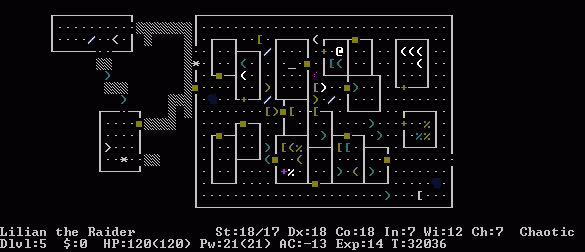Trending
Opinion: How will Project 2025 impact game developers?
The Heritage Foundation's manifesto for the possible next administration could do great harm to many, including large portions of the game development community.
Randomization is becoming an integral part of gaming. Before, it meant that monsters could randomly spawn - and not much more. But today, procedurally generated worlds are creating never-ending experiences and unique gameplay like never before.

It all started with the roguelikes. A popular subgenre of RPGs, roguelikes sought to create a brand new, exploratory experience every time a player started up a new game. Randomization in video games has been integral to the industry since as early as 1975, but it's really in the last few years that we've seen an incredible resurgence in interest.
Whether it's random aesthetic designs or randomized challenges, we're now seeing games shifting from a purely linear, on-the-rails format to a more emergent experience.
The original random: the 1980s dungeon-crawling Rogue
The relationship between video games and randomness has been a bumpy one. In the early years, randomness was associated with advanced game mechanics and challenges. The popular roguelike Nethack, created in 1987, could even be started in a game state that was impossible to "win."
This was an era before video games had to be "fair" and in which the experience was not necessarily about completing the game but instead about challenging the gamer to get farther and to experience more of it.

Nethack: a step forward in game design and randomization
But in a decade or two, game developers became obsessed with a different idea: the idea of telling a cinematic and challenging story. When games such as Myst began coming out in the early 1990s, game developers learned that video games could be used for more than just providing an environment and an experience.
This ushered in an era through which games became primarily about getting the player from point A to point B. And that's not to say that randomized games entirely disappeared, only that they were pushed towards the back of the industry. In fact, the most enduring games still have an element of randomness.
Myst has also transitioned to 21st century randomization with the new integration to Android
Two of the most popular games in the last decade have been Minecraft and The Sims. Minecraft creates an entirely procedurally generated world for the player to explore, often with other players. Often touted as a type of "digital Lego," Minecraft provides a brand new experience for people every time a new game world is created. And, even more interestingly, it is highly accessible. Children as young as eight can play the game on their own.

Similarly, though The Sims has a game world that the player themselves develops, the characters within the game are artificially intelligent and make their own decisions. The Sims became the largest and most popular game franchise in the world, particularly popular with casual gamers and again accessible to those of all ages.
And that doesn't mean that randomization is only used throughout casual games. The Elder Scrolls series is another game famous for procedurally generated artificial intelligence, and roguelikes themselves have experienced brand new interest with indie and popular games such as The Binding of Isaac and Gungeon.
 Stunning graphics and the ability to build-your-own-adventure helped Skyrim become a hit among gamers
Stunning graphics and the ability to build-your-own-adventure helped Skyrim become a hit among gamers
Not only are there more casual gamers today, but gamers themselves are finding that they don't have the time or the attention span for longer games. Randomized games have some incredible advantages for this growing subset of gamers.
Gamers can jump into a new experience every time. Rather than having to be locked into a specific story or following a plot line, gamers can boot up a game and play it for a few minutes. They don't have to worry about having forgotten where they were in the game or what tasks they were completing.
Gamers can get more value from a single game. When the game No Man's Sky was first announced, gamers were excited about the prospect of being able to explore the entirety of the universe within a single platform. The game didn't work out quite as it was supposed to, but the core conceit still got many players excited. Professionals in the industry saw it as the start of something more exciting: a game of infinite random possibilities, an ever-expanding gameplay that is unique for each player.
But randomization is not solely used for role-playing games and massive gameplay. They also need to be intricately developed and defined for games that feel more casual or simple, like Candy Crush. At first glance, they may not have as much depth. In reality, an analysis of a seemingly simple game from Winkbingo shows the necessity of developing intricate randomization algorithms that can create thousands of unique cards and levels and call out numbers as randomly as technology allows.
Gamers can define their own challenges. In an era in which gamers are an extraordinarily diverse demographic, there's no longer a "right" way to play games. In a randomized and generated game world, gamers can determine how they want to play. In games such as Minecraft, they could focus on creativity, survival, or exploration.
Gamers today have an extraordinary number of games to choose from but a limited amount of time to play them in. It's no wonder that they have begun gravitating towards games that can deliver unique experiences each time they are booted.
Randomization is getting better. In the early days of gaming, procedurally generated worlds meant that rooms were connected in a random way and that monsters could randomly spawn -- and not much more. But today, procedurally generated worlds can create entirely new environments, characters, and behaviors. As algorithms and artificial intelligence have become more advanced, developers have had more to work with.
Artificial intelligence truly became a discussion point when The Elder Scrolls introduced its Radiant AI system, designed to govern NPC behavior in a realistic way. Like many experiments, it didn't entirely enter into fruition, but it significantly changed the genre: rather than being entirely scripted, NPCs began moving towards realistic patterns of behavior.
This can be seen now in many popular open world games such as Grand Theft Auto as a way of adding realism into a world that is otherwise non-random. As artificial intelligence continues to grow and develop, we will likely see much more of this.
 The open world playability of GTA has created a cult classic among gamers
The open world playability of GTA has created a cult classic among gamers
But we'll also see more experiments in procedurally generated worlds, characters, and even stories. Though the above-mentioned game No Man's Sky may have been a somewhat historical flop, it clearly tapped into a need and desire for casual exploration that has been building throughout the gaming community. As the technology becomes more advanced, we'll see games create entire environments out of whole cloth.
Randomization in video games is something that has been critical to the industry and the community from the very start, as a way of keeping players interested, developing a unique experience, and even empowering the player to create their own story. It is likely that we will continue to see a shift towards more random, realer worlds in the coming years.
Read more about:
BlogsYou May Also Like